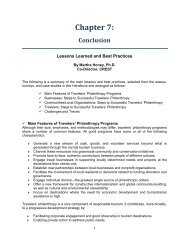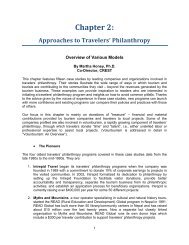Travelers' Philanthropy Handbook - Center for Responsible Travel
Travelers' Philanthropy Handbook - Center for Responsible Travel
Travelers' Philanthropy Handbook - Center for Responsible Travel
You also want an ePaper? Increase the reach of your titles
YUMPU automatically turns print PDFs into web optimized ePapers that Google loves.
• Philanthropic Giving<strong>Philanthropy</strong> is, of course, not a new concept. It comes from two Greek words: “phil” whichmeans “love <strong>for</strong>” and “anthrop” or “human.” <strong>Philanthropy</strong> is an act of helping based on love orstrong caring. The earliest recorded philanthropist was probably, as David Western notes in hisessay (next), the Good Samaritan who helpedneedy strangers he met while traveling. Thecollection plate passed during religious services isone of the oldest and most accepted <strong>for</strong>ms ofinstitutionalized charitable giving.Today, individuals represent the largest singlesource of philanthropic dollars. In the U.S.,individuals contribute 75% of philanthropic dollars,totaling $229 billion in 2007. 1 By 2020, individualcharitable giving in the U.S. is projected to exceed$300 billion. Private wealth is also growing in theUK, along with charitable giving by individuals. Inthe UK, there are over 168,000 active registeredcharities. 2Titi Conservation Alliance project, Costa Rica.Credit: Green Hotels<strong>Philanthropy</strong> UK, which tracks trends in giving, notes that there has been a significant shift inthe types of millionaires, from those who inherited wealth to those who are self-made. This shiftis resulting in a new type of philanthropist who is young, socially conscious, willing to take risks,and gives larger amounts. The new philanthropists also want to give during their lifetimes, asopposed to leaving a legacy through a bequest. They also want to experience the benefits ofgiving, develop a closer relationship with the beneficiaries, and see the impact and results oftheir support. Further, they place a high value on accountability and transparency from therecipients. 3 No one personifies the new approach to giving more than Bill and Melinda Gateswhose charitable foundation has given away almost $24 billion since 1994. 4While these trends cut across many national boundaries, there are differences in the cultures ofgiving between countries. For example, one can look at philanthropy in the U.S., the UK, andother countries in Europe.While U.S. government development aid, expressed as a proportion of GDP, is relatively lowcompared to that of other countries, donations from individuals, private organizations, andbusinesses are very high, dwarfing those of other rich nations. In the U.S., charitable givingrepresents 2.2% of GDP, while in the UK is only 1.1%, and continental Europe it is even less.This fits the observations of a number of writers in this <strong>Handbook</strong> that U.S. travelers are the“most generous” in supporting travelers’ philanthropy projects. Europeans are accustomed tostrong welfare states where their governments provide <strong>for</strong> social services, which has lessenedthe need <strong>for</strong> private funding. In contrast, in the U.S., philanthropy from both private individuals1In 2008, charitable giving in the U.S. declined <strong>for</strong> the first time in 12 years, with individual giving dropping by 6.3%. At the sametime, the worst recession in over 50 years brought with it a marked increase in demand <strong>for</strong> charitable services. “Federal NonprofitRe<strong>for</strong>m Charitable Giving IRA Rollover,” PANO Public Policy, http://www.pano.org/publicpolicy/publicpolicy-FederalRe<strong>for</strong>m.php.2 “About Charities,” Business Scene, April 20, 2007, http://www.businessscene.com/view_article.php?a=1089&PHPSESSID=1ce3f8d7c80159b2314fb2c8299b65023 <strong>Philanthropy</strong> UK, “A Guide to Giving,” 2005, http:philanthropyuk.org, quoted in Harold Goodwin and Claudia Eckardt, “<strong>Travel</strong><strong>Philanthropy</strong> Report, 2008,” World <strong>Travel</strong> Market, 2008, p. 1.4 “Foundation Fact Sheet,” Bill & Melinda Gates Foundation, http://www.gatesfoundation.org/about/Pages/foundation-factsheet.aspx.4















